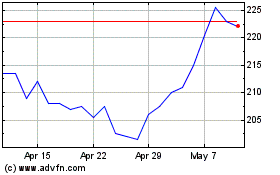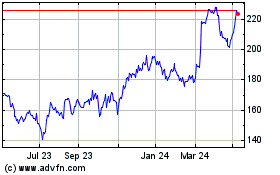Shariah-Compliant Interbank Funding Rate Set To Launch
November 22 2011 - 12:30AM
Dow Jones News
A group of 16 banks resolved a quandary that dogged the $1
trillion Islamic financing market for nearly three decades: how to
represent rates on interbank funding when Islamic moral principles
prohibit firms from charging interest.
The banks say the solution lays in considering money flowing
between banks as investments that depend on the performance of
underlying assets, rather than as interest-bearing loans.
Scholars and bankers involved in the project say it is an
industry milestone akin to the first globally issued Islamic
corporate bond in 2001, or the first Islamic sovereign bond in
2002.
Islamic banks cannot earn or pay interest, yet have been using
an international interest-rate benchmark--the London interbank
offered rate, or Libor--since 1986. While Libor isn't compliant
with the religious teachings of Islam, called Shariah law,
religious leaders permitted its use because there was no
alternative benchmark based on socially ethical investing.
The banks--working with industry associations and data provider
Thomson Reuters--created a Shariah-compliant reference rate called
the Islamic Interbank Benchmark Rate, or IIBR, which is set to be
used for the first time Tuesday. Also involved in the launch were
the Islamic Development Bank, the Accounting and Auditing
Organization for Islamic Financial Institutions, the Bahrain
Association of Banks and the Association of Islamic Banking
Institutions Malaysia.
"The establishment of the IIBR marks an important milestone in
the maturation of Islamic money markets by providing an
international reference rate for interbank transactions," said Dr.
Nasser Saidi, chair of the Islamic Benchmark Committee and chief
economist at the Dubai International Financial Centre, in a
statement.
Hassan Demirhan, director in the treasury department at the
Islamic Development Bank, added that the introduction of an
"indigenous Islamic benchmark" will prove to be a "major milestone
in the growth and sustainability of the industry."
Rather than measuring interest on loans as Libor does, IIBR uses
expected profits from short-term money and a forecasted returns on
the assets of the bank receiving funds. Both are considered
investments rather than loans, and therefore interest-free.
Sheikh Yusuf Talal Delorenzo, chairman of Thomson Reuters'
Shariah committee, said the significance of the IIBR rate is that
it allows firms participating "to see the interbank market in their
own terms."
"Earnings are lawful," he added. "What is unlawful is earnings
from interest."
IIBR on everything from overnight to one-year funding will be
determined from rates the member banks contribute each day. The
data will go through a type of cleaning called a "fixing," where
the top and bottom rates are removed and an average of the middle
eight contributions is taken.
The results are blessed by a panel of Islamic banks and approved
by a committee of Shariah scholars.
As of Nov. 16, the theoretical overnight IIBR rate would have
been 0.1%, which was slightly below the overnight Libor rate of
0.14%. Libor was cheaper over one year, however, at 0.91% versus
1.01% for IIBR.
Such differences could encourage corporate borrowers to use
Islamic banks when the IIBR rate is lower than Libor, on the theory
that banks could pass savings on to customers.
"It will facilitate liquidity into the Islamic banks," said
Rushdi Siddiqui, global head of Islamic finance at Thomson Reuters
in New York, who helped launched the first Islamic equity index in
1999 for Dow Jones.
Islamic banks have attracted liquidity from outside investors
interested in diversification, said Siddiqui, and this will provide
those funding sources with "a transparent, visible benchmark" that
will encourage increased funding flows, helping to finance a wave
of infrastructure projects in the region.
The development of a Shariah-compliant benchmark rate also comes
amid regulatory investigations into the way the Libor rate is fixed
by investment banks. Regulators have opted not to specifically
endorse IIBR over other benchmarks, preferring to remain neutral,
but they are aware of its creation and have supported it.
-By Katy Burne, Dow Jones Newswires; 212-416-3084;
katy.burne@dowjones.com
Tp Icap (LSE:TCAP)
Historical Stock Chart
From Mar 2024 to Apr 2024

Tp Icap (LSE:TCAP)
Historical Stock Chart
From Apr 2023 to Apr 2024
